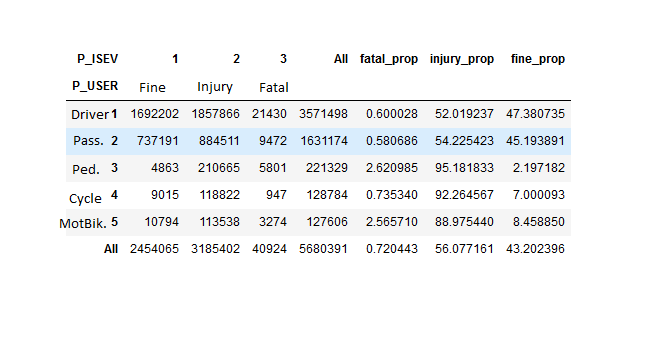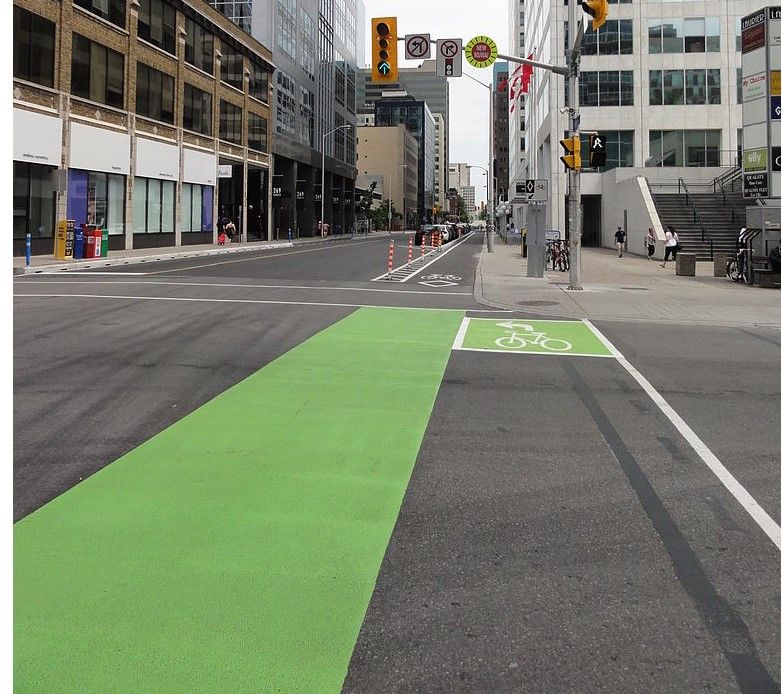Here’s a good news story for you. Last year, there were no cyclists killed in traffic accidents. The bad news is, there were still 270 collisions involving bicycles. Overall it looks like the resources being poured into bike safety are starting to pay dividends. And drivers are catching on.
If you spend any time around the roads, you’ll still see the occasional near-miss, or dangerous move. A lot of this is related to the way our roads are built.
Roads are engineered for automobile speed, and the comfort of drivers. On many streets, a full lane is dedicated to parking. Sidewalks are narrow and cramped, and bikes and transit are forced to share the space with cars.
In Ottawa, car is king. And that’s obviously not going to change in the near future. However, that doesn’t mean our streets need to feel like Mad Max for the most vulnerable users. Here’s a not so fun stat from the National Collisions Database.

I did a quick cross-tab of the data with Pandas, and came out with these results. As you can see, the most vulnerable road users, Pedestrians, Cyclists, and Bikers were much more likely to be injured or killed in an accident than automobile drivers or passengers.
The difference is startling, and shows just how unsafe other modes of transport are for users, when compared to cars. If involved in a collision, someone in a car has almost a 50% chance of being completely unharmed. A cyclist only has a 7% chance of coming out okay, and a pedestrian has a dismal 2% chance.
Granted, the injuries in this database can range from extremely minor to extremely grave, but the point is that the most vulnerable road users suffer disproportionately when involved in collisions.
Improved visibility for cyclists (bike lanes, media coverage) is possibly doing its part in reducing accidents. But it will take a concentrated effort to bring those numbers down further. Other nations take even more serious approaches to road safety, for all users, than Ottawa and Canada do. Perhaps we need to start modelling certain aspects of our systems off other countries.
In Germany, driver’s licenses require a much more intense study and training period before they are awarded. Drivers must attend 25-45 hours of mandatory driving instruction, another 12 hours of theory, and pay a lot of money for the licence.
Here, a driver does not even need professional lessons to get their licence, which means many drivers do not gain a formal education before taking the streets.
To keep other road users safe, improved education would be a step in the right direction. Specifically, education on how to pay attention to the road around you, and to always be on the lookout for cyclists, pedestrians, and motor bikes.
In the Netherlands, a country famous for its large amount of cyclists, there are further lessons to be learned. A technique known as the Dutch Reatch, employed by drivers parking their cars on the road, keeps cyclists safe from dooring. The driver will use their right (far) hand to open the door, which forces them to turn their body towards the road, and thus to look behind them. In this way, they will notice if a cyclist is passing by, and avoid hitting them with their door.
We are trending in the right direction, in terms of limiting collisions. Sadly, there are still collisions. From the Citizen Article:
“Total deaths from collisions rose, however, from 26 to 32: 20 drivers, four passengers in automobiles, five pedestrians and three motorcyclists. Only 10 drivers had died in 2016.”
Obviously, we have more work to do to improve the safety of our streets. And not just for cyclists and pedestrians, but for drivers as well. Some of this could occur through education. Other through improved road engineering – roads designed for slower driving could help save lives. Enforcement of safety laws can also be employed to improve road safety.
The chance is still too high, that someone coming home from work, or hockey, or vacation, could have their life ended on that trip. It’s up to all of us to help change it.
